Half the danger of the might not be so dangerous

This is the surprising result of an investigation by the police of the federal states and the federal criminal police office (BKA), report the "suddeutsche zeitung" and the broadcasters NDR and WDR. An almost equally coarse group, on the other hand, is considered highly dangerous.
Dangerous persons are those whom the security authorities generally trust to be capable of committing the most serious crimes, such as a terrorist attack. According to the report, the authorities are now using a new type of analysis system called radar-ITE, which was developed by the BKA and swiss scientists. It is based on 73 questions to be answered about socialization or attitudes toward violence. There were also questions about "protective factors" such as family ties, good integration or job security.
By the end of november, the authorities had completed 205 assessments. 96 islamists landed in the "moderate risk" category, 27 in "conspicuous risk" and 82 in the "high risk" category. Radar-ITE – the ITE stands for "islamist extremism" – is considered by the BKA in particular to be a suitable instrument for identifying particularly dangerous radicals. It should help to concentrate the surveillance of the heavily burdened investigative agencies and intelligence services on the relevant people.
From the point of view of the police union (gdp), it is hardly possible to monitor islamist threats completely. "Firstly, there are strict limits to such an encroachment on personal rights. And secondly, the police deploy around 24 officers for a 24-hour observation. So there is simply a lack of capacity and the legal basis," gdp federal chairman oliver malchow told "heilbronner stimme" (monday).